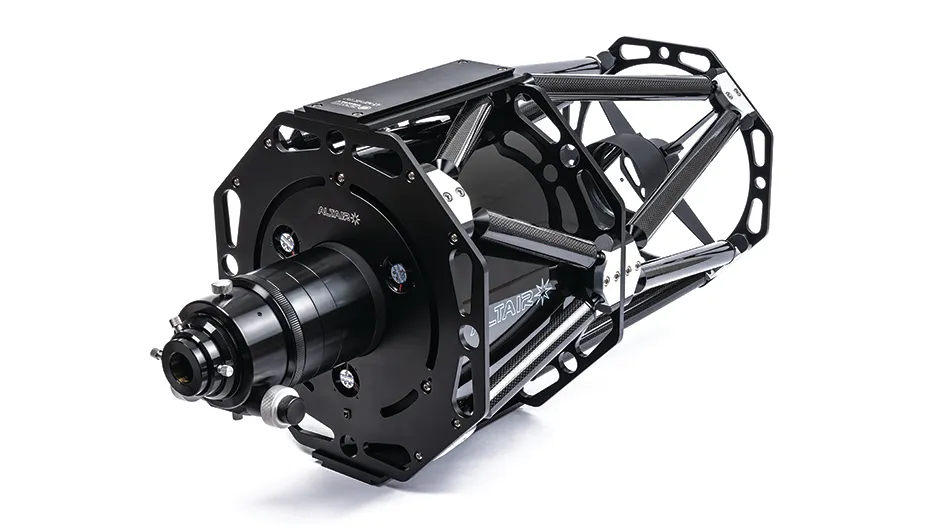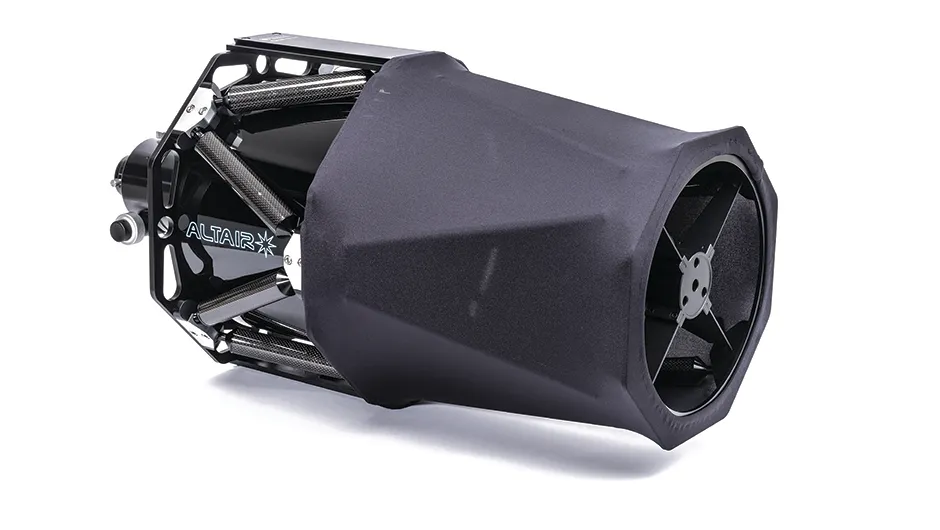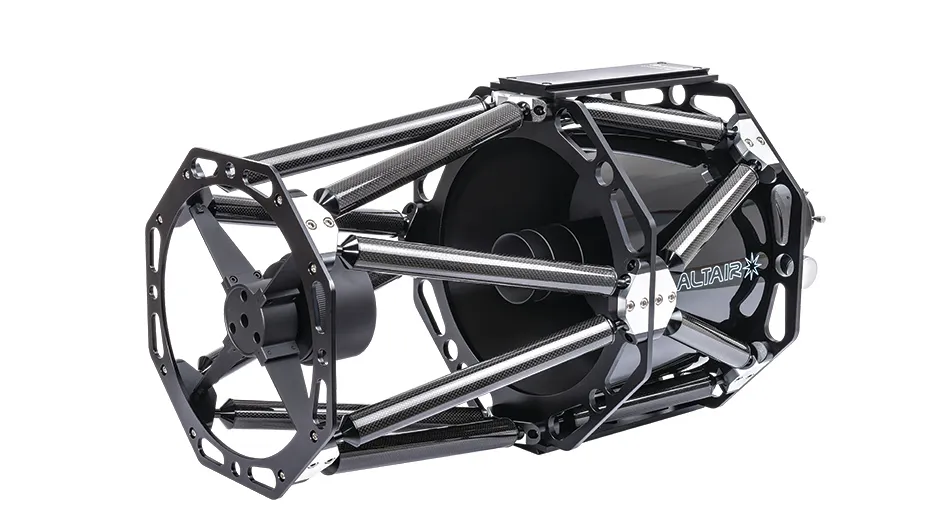Price: £2599.00
Aperture: 250mm (10 inches)
Focal Length: 2000mm f/8
Weight: 15.9kg
Supplier: Altair Astro
Telephone: 01263 731505
Website: www.altairastro.com
Despite the truss tube being the design of choice for professional observatories, it is rare to find this type of construction in amateur telescopes, with the exception of larger Dobsonian reflectors.
However, the Altair Astro RC250-TT astrograph follows in the footsteps of many of its larger professional cousins by implementing a Serrurier truss design.
The telescope has a handsome, functional appearance, but closer examination reveals a wealth of lovely detail in its construction.

The carbon fibre truss rods are finely made and the anchorage points are neatly finished in satin alloy.
These anchorage points attach to three 8mm-thick CNC-machined alloy mounting plates using stainless steel cheese-head Allen bolts.
The rigidity of the whole construction is further enhanced by the inclusion of two Losmandy-style dovetail bars.
The primary mirror has a gloss black finished cowl to protect it from stray light.
The scope’s 2,000mm focal length is achieved by folding the light path within a tube just 605mm long by way of a Ritchey-Chrétien mirror set.
This design uses finely figured hyperbolic primary and secondary quartz glass mirrors with dielectric coatings to produce a well illuminated, coma-free field of view.
We measured the field of view at 40.7x27.1 arcminutes using our APS C sensor, making the telescope most suitable for imaging smaller deep-sky objects such as galaxies, globular clusters and planetary nebulae.

Balancing act
The Crayford focuser is of a later type, incorporating a linear bearing that increases the load capacity for carrying photographic equipment.
However, even with this design, the focuser is only really suitable for a DSLR camera or a small CCD camera with a lightweight filter wheel, though it did handle our one-shot-colour CCD camera and a lightweight off-axis guider.
To achieve focus, we installed both a 2-inch and a 1-inch extension tube behind the focuser. These, plus a second 1-inch extension tube, were supplied with the telescope.
They are designed to move the focuser outwards from the rear of the telescope rather than adding extension after the focuser.
This is a very sensible design, as it makes for a very secure focuser attachment and avoids any unwanted sagging in the light path that would lead to misshapen stars.
The secondary mirror is mounted in a substantial spider assembly with four vanes and is protected from stray light by a small matt-black metal cowl that forms part of the adjustable mirror cell.

This adjustable cell works in a similar manner to that of a Newtonian reflector or Schmidt-Cassegrain telescope and controls collimation by adjusting three Allen bolts at the front of the telescope.
The relatively large central obstruction of 44 per cent – caused by the secondary mirror – robs the telescope of some contrast when viewing fine detail in Solar System objects.
However, Jupiter was very well placed during the period of our review and we couldn’t resist an observing session even though this instrument is designed specifically for imaging.
We certainly weren’t disappointed with our observations of the planet and its moons, and moved on to enjoy excellent views of various galaxies including the Leo Triplet, Bode’s Galaxy and the Cigar Galaxy.
Staying with the Cigar Galaxy, we swapped our eyepieces for an imaging setup and took a series of nine 600-second exposures.
The recent supernova in this galaxy, SN 2014J, was fading by this time but we wanted one more image of it to test out the telescope’s optics.
We were pleased with the final result, which showed just a small amount of vignetting, easily fixed with a set of flat frames.
We noted that the stars at the very periphery of the field of view showed a slight elongation caused by field curvature and would recommend that an Altair Astro Ritchey-Chrétien 1.0x field-flattener is used for APS and larger sensors.
Overall, however, we were very impressed with the RC250-TT and would recommend it to intermediate astrophotographers with a suitably substantial mount to handle it.
Serrurier truss
The Altair Astro RC250-TT has a beautifully manufactured Serrurier truss design with a non-structural steel cowl to protect the primary mirror.
This special truss construction was originally designed in 1935 by Mark Serrurier, an engineer working on the 200-inch Mount Palomar Hale Telescope.
The elegant but complex design uses two sets of four opposing truss tube sections that work in harmony to keep the primary and secondary mirrors parallel to one another and, therefore, correctly collimated no matter what orientation the telescope is placed in.

The individual truss rods are made from carbon fibre, chosen not only for its rigidity, strength and lightness, but also for its excellent thermal properties, which means there is very little contraction or expansion due to changes in ambient temperature.
This helps to keep the telescope in focus over protracted periods of time.
An open truss design like this also helps enormously with the all-important cool-down time: as there is no ‘tube’ as such, fine detail-destroying tube currents are eliminated.
Collimation bolts
The secondary mirror in a Ritchey-Chrétien telescope is held in a spider vane in the same manner as a Newtonian reflector.
The review telescope required a minor tweak to the secondary to collimate it, but this was simple to do using a 4mm Allen key to adjust the three collimation bolts in the secondary mirror cell.
Dovetail bar
The rear section of the truss tube has a pair of Losmandy-style dovetail bars installed.
This style of bar is ideal for an instrument of this size and weight as it provides a very sturdy installation on a suitably equipped mount.
The second dovetail bar adds both rigidity and an accessory mounting location.
Crayford focuser
The dual speed 10:1 reduction linear bearing Crayford focuser allowed for easy focusing with no backlash or image shift. The 3-inch diameter focus tube helped to produce a well-illuminated image frame.
The focus lock, with its large chrome locking knob, supported the weight of our one-shot-colour camera adequately.
Mirror cooling fans
An open truss design is excellent for allowing the telescope to reach thermal equilibrium with the atmosphere, but the large 10-inch primary mirror can continue to retain heat, leading to unwanted disturbed air just above the mirror’s surface.
The three fans in the rear of the telescope help to cool the primary mirror quickly.
Light shroud
The very nature of an open truss design like the RC250-TT allows extraneous light to enter the telescope and reach the primary mirror.
The supplied black nylon shroud was very effective at blocking stray light and increasing contrast; it also helps to keep dust away from the mirrors.
This review originally appeared in the June 2014 issue of BBC Sky at Night Magazine.
